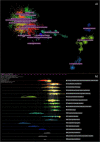Trends and Developments in Mindfulness Research over 55 Years: A Bibliometric Analysis of Publications Indexed in Web of Science
- PMID: 34306245
- PMCID: PMC8282773
- DOI: 10.1007/s12671-021-01681-x
Trends and Developments in Mindfulness Research over 55 Years: A Bibliometric Analysis of Publications Indexed in Web of Science
Abstract
Objectives: This study aimed to identify historical developments, active research areas, and emerging trends within scientific literature on mindfulness published so far, using bibliometric methods. We also aimed to identify prominent journals, authors, organizations, and countries in the field of mindfulness.
Methods: Articles or reviews which mention mindfulness in the title, abstract, or keywords were identified using the Web of Science. A descriptive summary of the literature was obtained from the Web of Science Analysis tool. Country collaboration, co-authorship, and keyword co-occurrence networks were visualized using VOSviewer. CiteSpace, which uses document co-citation analysis, was used to identify emerging trends and transient patterns in the literature.
Results: From 1966 to 2021, 16,581 publications on mindfulness were identified. There has been an exponential growth of publications since 2006. Almost half (47%) of the publications were in psychology and about one-fifth (20.8%) in psychiatry. The most prolific journal was Mindfulness (contributing 7% of all publications) and the most prolific author was Eric L. Garland. The vast majority of publications originated from Western countries but representation from Asian countries has increased. The most frequently co-occurring keywords were meditation, depression, stress, and anxiety. Co-citation analysis of the early period (1966-2015) revealed how scholarly work on spiritual themes has inspired early mindfulness research. Recent trends (2016-2021) revealed a rising interest in mechanisms and moderators, long-term meditation, neuroscientific studies, and smartphone/online delivery of interventions.
Conclusions: This comprehensive bibliometric study summarized and visualized 55 years of mindfulness research, revealing pivotal points, active research areas, and emerging trends.
Keywords: Bibliometrics; Co-citation analysis; Mindfulness; Patterns; Trends.
© The Author(s), under exclusive licence to Springer Science+Business Media, LLC, part of Springer Nature 2021.
Conflict of interest statement
Conflict of InterestThe authors declare no competing interests.
Figures










References
-
- Baer RA. Mindfulness training as a clinical intervention: A conceptual and empirical review. Clinical Psychology: Science and Practice. 2003;10(2):125–143. doi: 10.1093/clipsy.bpg015. - DOI
Publication types
LinkOut - more resources
Full Text Sources
